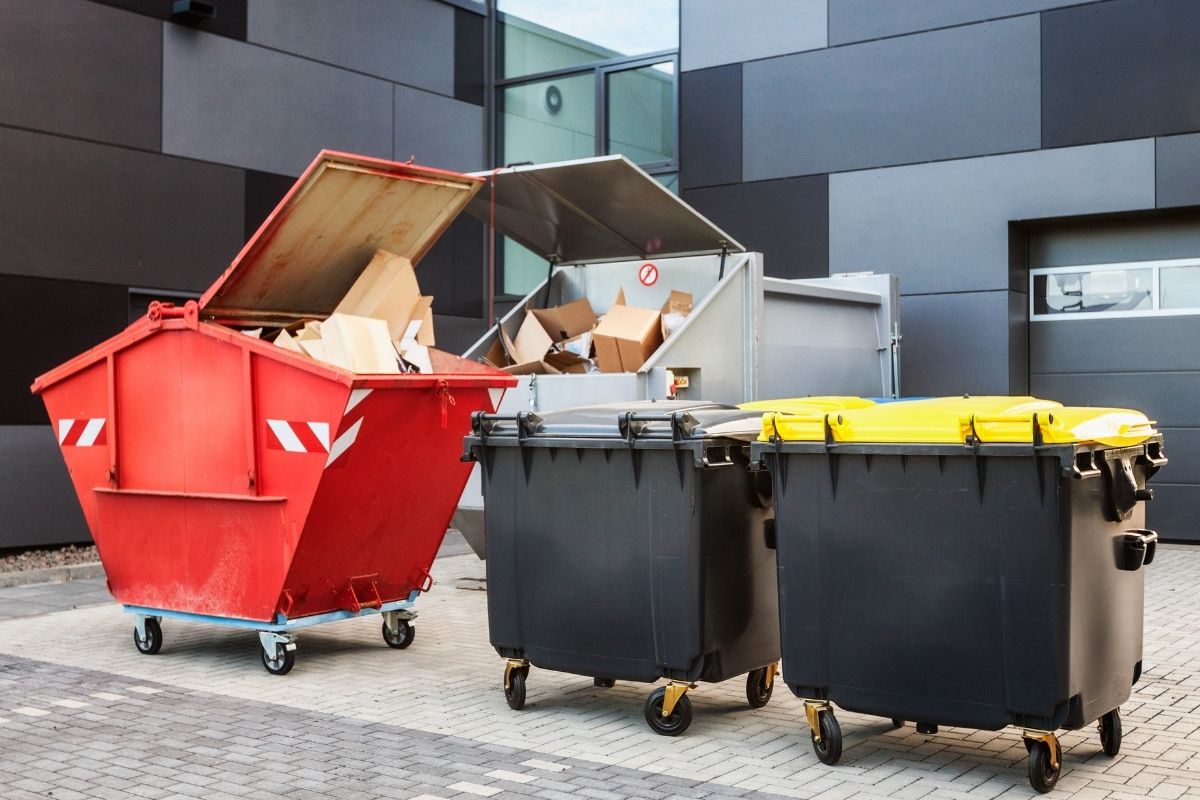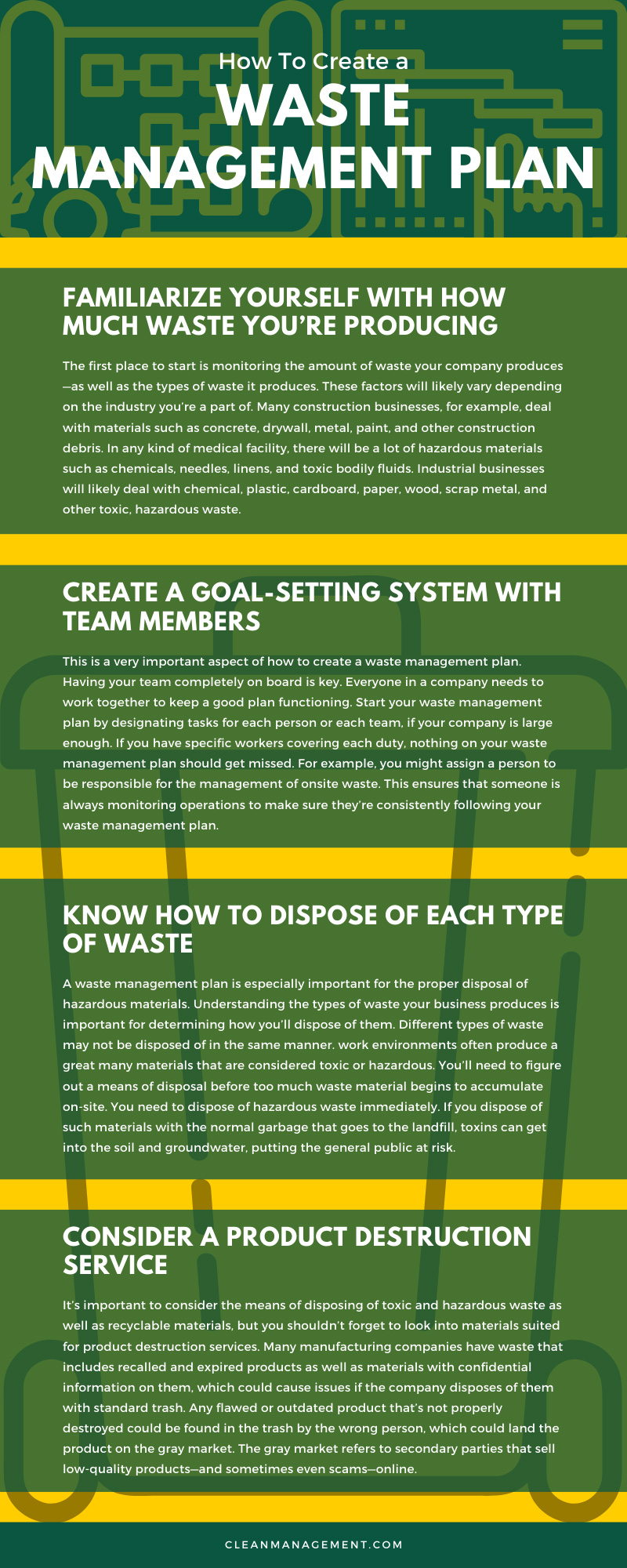How To Create a Waste Management Plan

Many businesses across many industries tend to produce high amounts of waste. They must deal with a lot of this waste through proper procedures, as much of it may be hazardous material. The hazardous nature of some kinds of waste makes it necessary for companies to have plans of action known as waste management plans. It’s important for businesses to utilize their waste management plans to lower their operating costs and increase their overall efficiency. These plans can also further the company’s environmental credibility.
The concept of a waste management plan is to give your company guidance on proper storage and the means of disposal of the waste your facilities generate. Learn further as we break down the different steps to show you how to create a waste management plan.
Familiarize Yourself with How Much Waste You’re Producing
The first place to start is monitoring the amount of waste your company produces—as well as the types of waste it produces. These factors will likely vary depending on the industry you’re a part of. Many construction businesses, for example, deal with materials such as concrete, drywall, metal, paint, and other construction debris. In any kind of medical facility, there will be a lot of hazardous materials such as chemicals, needles, linens, and toxic bodily fluids. Industrial businesses will likely deal with chemical, plastic, cardboard, paper, wood, scrap metal, and other toxic, hazardous waste.
Documenting what types of waste and how much waste your company produces will help you set up a waste management plan that will accurately calculate what you need to do to efficiently and safely dispose of such material. You can do your own waste audit, or you can hire a specialist to guide you through the process. It’s important to make sure you’re documenting any consistent trends throughout your analysis. Consider from your audit which areas your company needs to improve upon. Note the materials you throw away most often, and then think of ways you can minimize the amount. Save this data so that you can later compare it to your new data in order to track your progress of reducing waste.
Create a Goal-Setting System with Team Members
This is a very important aspect of how to create a waste management plan. Having your team completely on board is key. Everyone in a company needs to work together to keep a good plan functioning. Start your waste management plan by designating tasks for each person or each team, if your company is large enough. If you have specific workers covering each duty, nothing on your waste management plan should get missed. For example, you might assign a person to be responsible for the management of onsite waste. This ensures that someone is always monitoring operations to make sure they’re consistently following your waste management plan. Make sure you’re clear about your expectations for your employees regarding the company’s waste management plan going forward.
It’s vital for each of your employees to know his or her responsibilities in properly managing waste. That means they need to be diligent about properly discarding any kinds of waste your facility produces. Make sure to communicate your goals and expectations with your employees. When you have set your goals, evaluate them frequently to gauge your progress in meeting them. Companies often have to revisit these kinds of plans as time goes on. Depending on your business, your product or the types of materials you use may change, which could change the types and amounts of waste you produce. Therefore, it’s wise to consider that you may need to adjust your plan in the future.
Know How To Dispose of Each Type of Waste
A waste management plan is especially important for the proper disposal of hazardous materials. Understanding the types of waste your business produces is important for determining how you’ll dispose of them. Different types of waste may not be disposed of in the same manner. You’ll need to figure out a means of disposal before too much waste material begins to accumulate on-site.
As we mentioned, work environments often produce a great many materials that are considered toxic or hazardous. You need to dispose of hazardous waste immediately. If you dispose of such materials with the normal garbage that goes to the landfill, toxins can get into the soil and groundwater, putting the general public at risk. Aside from these hazardous materials, there are other materials you’ll want to avoid disposing of incorrectly, as you could be wasting recyclable resources. Unfortunately, many companies throw materials such as plastic, glass, and cardboard straight into the trash. We recommend noting the essential three Rs: reduce, reuse, and recycle. Identify any recyclable or reusable materials your company wastes, and make this a part of your waste management plan. When you make sure to recycle every reusable material, you make your industry much more sustainable.
Consider a Product Destruction Service
It’s important to consider the means of disposing of toxic and hazardous waste as well as recyclable materials, but you shouldn’t forget to look into materials suited for product destruction services. Many manufacturing companies have waste that includes recalled and expired products as well as materials with confidential information on them, which could cause issues if the company disposes of them with standard trash. Any flawed or outdated product that’s not properly destroyed could be found in the trash by the wrong person, which could land the product on the gray market. The gray market refers to secondary parties that sell low-quality products—and sometimes even scams—online. When these parties sell products with your company’s name still on them, it could harm your brand’s reputation.
Furthermore, any confidential information—such as billing or bank account information—getting into the wrong hands could have incredibly disastrous results. This includes the hacking of your accounts and loss of funds, whether individual or those belonging to the company. A product destruction service will take any of these kinds of material and properly destroy them, making sure no one on the outside can ever get to them.

